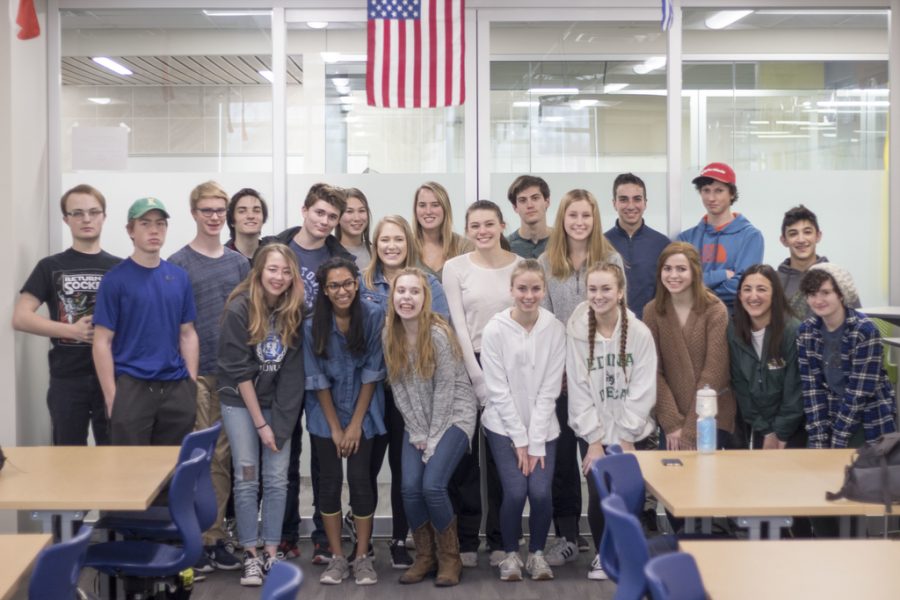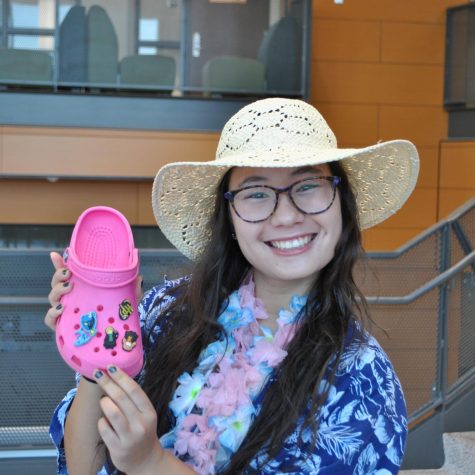Students, Faculty, and Link Crews Offer Mid-Year Perspective on Advisory, Flex
Link Crew Leaders Anna Karos, Ian Klein, and MK Sipes with their 10th grade “Crew.”
February 23, 2018
In the fall of 2017, Edina High School rearranged its weekly schedule in order to accommodate its first-ever freshmen class. Now, a typical week consists of three seven period days, one odd period block day, and one even period block day, which includes advisory and Flex time. The new advisory and flex times have experienced various successes and challenges.
Advisory was once only a middle school class, but the administration saw value in bringing an advisory program over to the high school, especially as a way to bridge the gap between the middle and high school experience. Each Thursday, students are required to attend a grade-level advisory and participate in activities such as academic check-ins, postsecondary planning, and discussions about upcoming school events.
Many students believe that while advisory was useful in the beginning of the school year, it has started to recycle the same information. “It seems in the beginning, I did gain valuable knowledge. But we end up repeating a lot of the same things over and over again,” junior Elena Elie said.
A potential alternative to face-to-face advisory that is an appealing prospect to many students is for the school administration to send out the information through email, Schoology, or videos. However, with that approach, there’s no guarantee that students would read or listen to these messages. Elie argues that some students won’t listen either way. “Whether you sit us in an auditorium, people are always not going to listen. You send out an email, people aren’t going to read it. You have the same kids not listening either way.”
The social studies department recently brought up another idea for a compromise: EHS should have advisory in order to relay information about college applications, Naviance, and Senior May Term, but advisory doesn’t need to meet weekly. “I do support advisory but our department at least feels like sometimes those minutes could be better allocated to time in the classroom with teachers, getting help,” social studies teacher Elizabeth Nimmo said. Nimmo and her department colleagues suggest that on weeks when there wasn’t advisory, the Thursday afternoon schedule could instead consist of two Flex blocks: Flex A and Flex B. X
Under the current system, teachers are able to invite students to their Flex time early in the week. If a student isn’t invited to a teacher’s Flex, they can decide between attending a teacher’s Flex time, or a silent or collaborative study. If you’re a junior or senior with a release sticker, you can go home. Whether a student is invited or signs up independently for a teacher’s Flex time, they are required to stay in that classroom for the entire Flex. However, with a Flex A and Flex B system like the one social studies is proposing, a student could visit two different classrooms. For instance, if a student needed to take a biology quiz but also has questions about an essay, they could attend Biology Flex A and English Flex B, similar to last year’s version of Flex, called Collab which occured twice per week. Two Flex times would allow for teachers to provide additional assistance to their students. “If there are minutes that aren’t being well utilized, we would love to see our students more. We’d love to have more Flex time,” Nimmo said.
Another aspect of advisory that EHS feels mixed about is Link Crew, a peer-mentoring program designed to guide the new students during their transition to high school. Though in most schools, only freshman advisories have Link Crew mentors, at least for this year, sophomore advisories at EHS have also been paired up with Link Crew leaders. The sophomores and freshman have occasional “Link days,” when their corresponding Link Crew Leaders conduct specific activities that they learned during the previous week’s advisory.
On the first day of school, Link Crew Leaders welcomed new students, helped them find their classes, and led community-building activities during advisory. It was very successful and brought a lot of attention and support to the program. Link Crew Coordinator Jonathan Buckley remembers how Link Crew Leaders built a tunnel for all the students coming off the buses. “The first thing I noticed was that they actually were smiling, some of them were smiling kind of like ‘What’s going on?’ but they were smiling. And I was thinking how many students on the first day of school, when they’re brand new, walk into the building and they have a big huge smile on their face. A lot of time they’re so nervous, so I thought that was really neat.”
Despite a great first day, Link Crew has faced challenges, namely connecting with students. Since the activities are similar to WEB (Where Everybody Belongs), a program that helps transition previous elementary students into the middle schools, some underclassmen feel as if they are being treated younger than their age. This shared feeling often led to Link Crew leaders facing resistance in the classroom. “If you would compare the students to the first semester and this [second] semester, the first semester they were taking it seriously, doing the activities. But now, it’s like ‘Uh do we have to do an activity today?’” junior Link Crew Leader Deka Xasan said.
The Link Crew Coordinators, named the Link Five, recognize the challenges. They’re working to improve the new program and focusing on “how to provide opportunities for regular and constant contact of the Link Crew Leaders with the students they’re working with,” Buckley said. They love the program and see great potential to create a positive culture at EHS, and provide support to its students. “We’re really excited to make adjustments and changes to make next year even better than this year. Hats off to our Link Crew leaders, this is #yearone,” Buckley said.
Link Crew has similar feelings about how often advisory should be held. Despite being close to and liking her Link Crew Leaders, sophomore Tiffany Qian thinks “the first two weeks it would be really helpful to have a Link Crew Leader that you could talk to on a daily basis but afterwards it’s unnecessary”.
Regardless of the challenges, the 220+ Link Crew Leaders have experienced general success. “I got a lot closer with the people in Link Crew and I made a lot of new friends… I’ve enjoyed Link Crew so far, so yes I will join again,” Xasan said.
Flex, advisory, and Link Crew are all new to EHS, and it is clear that while there are many things working about these changes, there is also room for improvement. Overall, semester one at EHS was successful and next year will bring even more growth and improvement.



